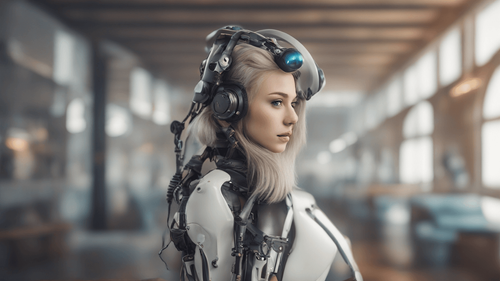
Explore the world of human-like chatbots, their impact on customer interactions, and how they are revolutionizing the customer service landscape.
Introduction
In a rapidly evolving digital era, where customer interactions are becoming increasingly virtual, businesses are striving to create more personalized and engaging experiences. Enter the realm of "Human-Like Chatbots," the cutting-edge innovation that bridges the gap between technology and human interaction. These advanced AI-powered entities are redefining customer service, enhancing user experiences, and transforming the way companies connect with their audiences.
Human Like Chatbot: The Next Evolution in AI
Understanding Human-Like Chatbots
Human-like chatbots, often referred to as conversational agents, are AI-driven virtual assistants designed to simulate natural conversations with users. They leverage Natural Language Processing (NLP) and Machine Learning (ML) techniques to understand context, decipher intent, and provide contextually relevant responses. This technology goes beyond simple scripted responses, enabling chatbots to engage in dynamic, human-like conversations that reflect empathy, comprehension, and personality.
Key Features of Human-Like Chatbots
-
Natural Language Understanding (NLU): Human-like chatbots employ sophisticated NLU algorithms to comprehend user inputs, including slang, idioms, and context, leading to more accurate responses.
-
Contextual Memory: These chatbots possess the ability to remember past interactions, ensuring seamless and coherent conversations over multiple sessions.
-
Emotional Intelligence: Through sentiment analysis, chatbots can gauge user emotions and adjust their responses accordingly, enhancing user satisfaction.
-
Multilingual Capabilities: Many advanced chatbots support multiple languages, facilitating global interactions and catering to diverse audiences.
-
Personalization: By analyzing user data, human-like chatbots offer personalized recommendations and solutions, creating a tailored user experience.
Benefits of Human-Like Chatbots
Enhanced Customer Engagement
Human-like chatbots revolutionize customer interactions by providing real-time assistance that feels more personal and authentic. They offer round-the-clock support, addressing queries, resolving issues, and guiding customers through various processes. This enhanced engagement leads to improved customer satisfaction and loyalty.
Efficiency and Scalability
Unlike human agents, chatbots can handle multiple interactions simultaneously, ensuring prompt responses and reducing customer wait times. This scalability enhances operational efficiency and streamlines customer service workflows.
Seamless Omnichannel Experience
Human-like chatbots seamlessly integrate with various communication channels, such as websites, social media, and messaging apps. This consistency ensures a unified brand experience, regardless of the platform customers choose to engage on.
Data-Driven Insights
By analyzing interactions, chatbots generate valuable insights into customer preferences, pain points, and behaviors. These insights empower businesses to refine their strategies, improve offerings, and enhance customer journeys.
Cost Savings
Implementing human-like chatbots significantly reduces operational costs associated with maintaining large customer support teams. Businesses can allocate resources more strategically while still offering exceptional customer service.
Challenges and Considerations
Maintaining Authenticity
While human-like chatbots strive to emulate human interactions, ensuring authenticity in all scenarios can be challenging. Striking the right balance between automated responses and human touch is crucial to avoid frustrating users.
Ethical Implications
As chatbots become more sophisticated, ethical considerations arise, particularly in scenarios where users might not realize they are interacting with an AI entity. Transparency and clear communication are vital to build trust.
Continuous Learning
Human-like chatbots rely on ongoing learning to improve their responses and accuracy. Constant updates and refining of algorithms are necessary to keep the chatbots effective and up-to-date with evolving language patterns.
FAQs
How do Human-Like Chatbots Learn to Mimic Human Conversations?
Human-like chatbots learn through a combination of supervised and unsupervised learning. They are trained on vast datasets of human conversations, allowing them to understand context, intent, and nuances in language.
Can Human-Like Chatbots Understand Multiple Languages?
Yes, many human-like chatbots are designed to understand and respond in multiple languages. They leverage advanced NLP techniques to provide accurate and contextually relevant responses across various languages.
Are Human-Like Chatbots Suitable for All Businesses?
Human-like chatbots can benefit businesses across industries, but their suitability depends on the nature of the business and customer interactions. Companies with high customer engagement and frequent interactions stand to gain the most.
How Do Human-Like Chatbots Impact Job Roles?
While chatbots streamline routine tasks, they also free up human agents to focus on more complex and value-added interactions. This shift in responsibilities can lead to the creation of new job roles centered around AI management and maintenance.
Do Users Prefer Human-Like Chatbots Over Human Agents?
User preferences vary, but many users appreciate the efficiency and accessibility offered by human-like chatbots. However, certain scenarios, especially those requiring emotional support, might still require human intervention.
What's the Future of Human-Like Chatbots?
The future holds exciting possibilities for human-like chatbots. As AI and NLP continue to advance, chatbots will become even more adept at understanding and generating human-like responses, further blurring the lines between human and machine interaction.
Conclusion
In the dynamic landscape of customer interactions, human-like chatbots emerge as transformative tools that meld technology and humanity. With their ability to engage, assist, and personalize interactions, they offer businesses an unparalleled opportunity to connect with their audiences. As technology evolves and AI continues to progress, the future looks promising, with human-like chatbots poised to revolutionize customer service, enrich user experiences, and redefine the way we communicate. Embrace this AI-driven evolution, and unlock a new era of customer engagement and satisfaction.